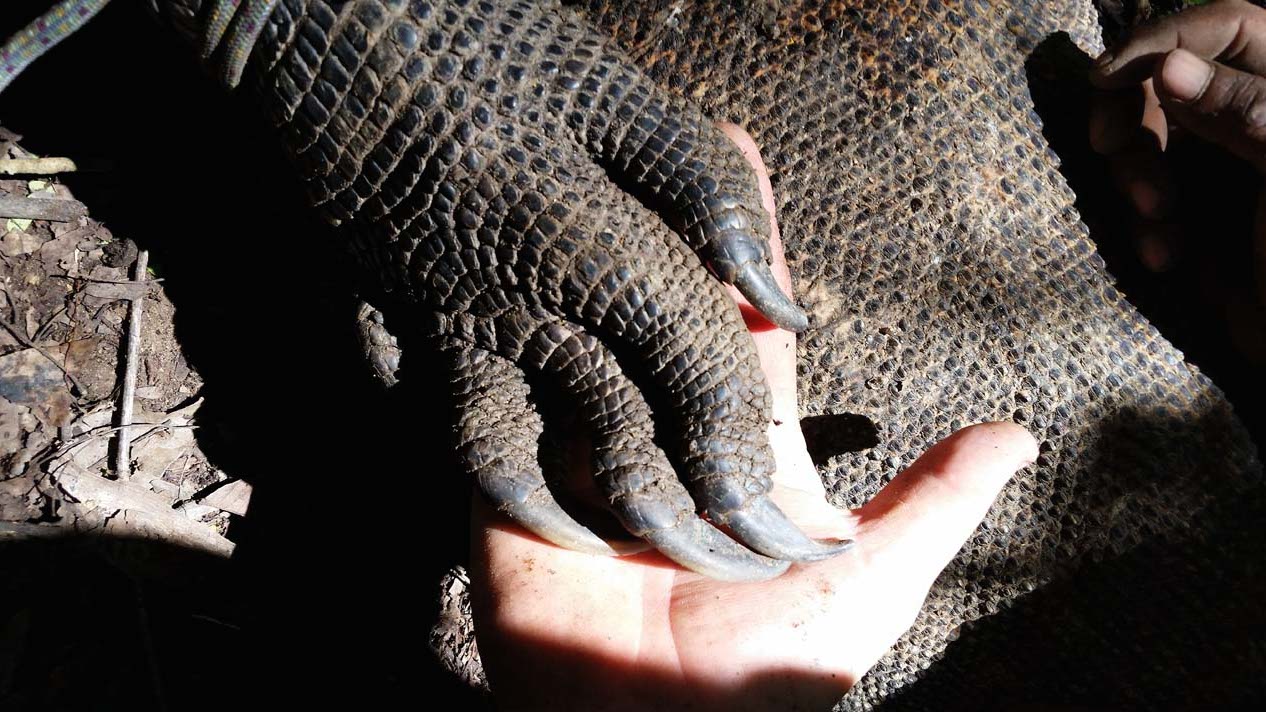A New Jersey zookeeper embarks upon the adventure of a lifetime, catching and releasing Komodo dragons.
I jumped off the skiff 30 feet from shore, ready for adventure — ready for dragons. My feet felt the Indian Ocean for the first time. I enjoyed the cool water on my legs, and marveled at the island. I could see how movie producer Merian C. Cooper had gotten the idea for the original movie “King Kong” here. Mysterious green mountains jutted from the sea like giant turtle heads coming up for air.
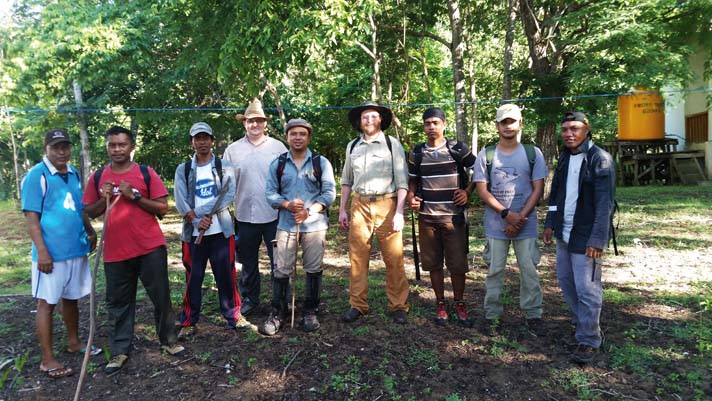
mike wines
The Dragon Trappers, from left to right: Jawa Hadi (chef), Kamal (Komodo National Park ranger), Agus Supandi (field assistant), the author, Achmad Ariefiandy (co-lead researcher), Peter Miller (Woodland Park Zoo), Wandi (field assistant), Sanggar Abdil Nasu (Komodo National Park junior staff), M. Sidiq (field assistant).
I stumbled to the beach, and sitting 60 feet away, where the sand turned to grass, was the biggest Komodo dragon I had ever seen. He could have been a statue, but wasn’t. He was the real thing. He was a real, live dragon — and he was looking right at me. I’m ashamed to say the first words I uttered on that magical shore was a string of swear words: “Divine copulating manure!” I exclaimed. (This isn’t exactly what I said, of course, but it’s close enough for this audience.)
The dragon was at least 8 feet long and had to weigh over 150 pounds. The dirt-brown scales lay over his skeleton like a dusty blanket. He was an old man. The base of his tail was sunken. He was covered in gnarly scars from years of hard living. He’d fought and beaten beasts bigger and meaner than me. The dragon sat there as if considering whether or not I was worth the trouble of murdering for a snack. I stood bravely with nothing between us and tried not to pee my pants. The animal made up his mind and continued with his nap.
“Adventure!” I yelled, much to the surprise of everyone around me. They had been carrying the gear to the beach as I stared at the dragon like a tween girl bumping into Justin Bieber in a dark parking lot while he was carrying an AK47. It was the coolest, most awesome, frightening thing I’d ever seen.
Let me convey the background to my excitement. I’m a herpetologist. I work with many species, but Varanus komodoensis is by far my favorite. I’m currently a zookeeper at the Turtle Back Zoo in West Orange, N.J., where I am basically a butler to a Komodo dragon. Before that, I worked with dragons at the Memphis Zoo for several years. I’ve read the books, watched the documentaries, studied the biology, and daydreamed about the creatures all of my life.
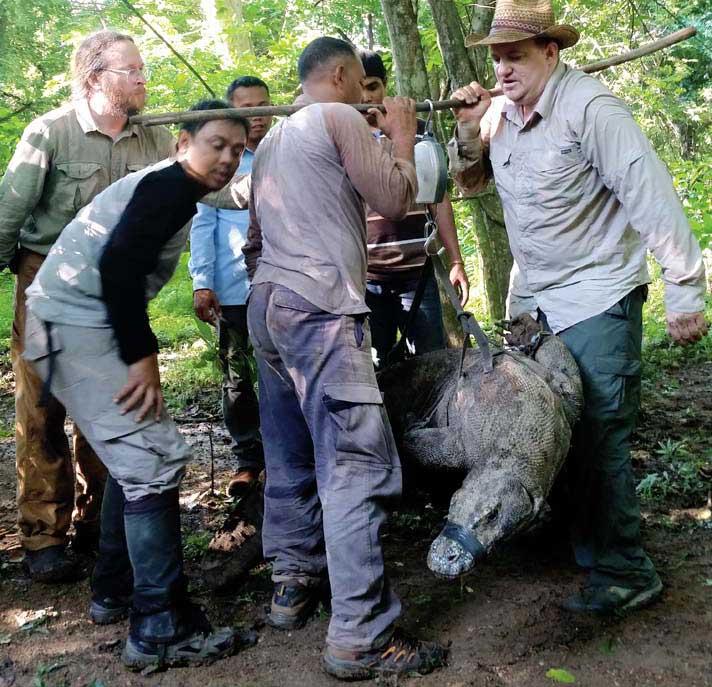
mike wines
The team hefts Dragonzilla, who measured 10.2 feet in length and weighed 231 pounds.
I got the opportunity to go to Indonesia to help with a long-term research and conservation project through the American Zoological Association (AZA). They work closely with the Komodo Survival Program (komododragon.org). The AZA donates money to the conservation project, and in return, two AZA zookeepers get to go to Komodo to work with the group every year. Peter Miller (my friend and fellow dragon butler from the Woodland Park Zoo in Seattle) and I were chosen to go learn about the animals in the wild. The Zoological Society of New Jersey funded my trip, and for that, I am forever grateful. It was the opportunity of a lifetime.
Komodo Island Arrival
Getting to Komodo Island from Newark, N.J. required three planes (about 24 hours flying) to Indonesia, followed by three days in Ubud, a night in Labuan Bajo, and a four-hour boat ride. Finally, after all the travel and 40 years of being obsessively fascinated, I stood on Komodo Island among the dragons.
There are many languages spoken in Indonesia. I spoke none of them. So when I excitedly yelled things, people had no idea what I was saying. The main researcher, Achmad Ariefiandy, spoke several languages, including English, so he translated for everyone. He also answered all my questions, and I had a lot. Needless to say, Achmad was one of the most patient men I’ve ever met.
After the initial adrenaline wore off, we set up camp. I stayed in a tent on the concrete porch of a ranger station. I referred to my tent as the microwave burrito after the first night. It was over 100 degrees Fahrenheit, and there was no breeze. I considered sleeping outside the tent, but there was almost always a dragon not too far off. Achmand happily reassured me that dragons didn’t eat at night. For some reason I felt a little more secure in a tent than out of one while unconscious. I felt like a Twinkie, safe in its wrapper.
Read More
A Visit to Indonesia's Komodo National Park
Google Honors 37th Anniversary of Komodo National Park in Indonesia
There was no electricity, except for a few hours in the evening when a generator would be used. The running water was hard to catch, and the toilet was a hole you squatted over. Adventure! The accommodations were tough. It was extremely hot. Some of the sunny spots on the ground got up to 150 degrees! We had great food, however. Even though I ate as much as I could, I still lost 12 pounds in just 10 days.
Dragon Catchers
Our first morning on the island, we set out to catch dragons. After breakfast, I grabbed a Y-shaped stick and my gear. Have I mentioned that I was excited?
I felt like Indiana Jones, but looked more like a chubby pink farmer. But whatever — I was on an adventure! Peter and I joined the rest of the team, made up of two researchers, a park ranger, and several locals hired to help. Peter and I had worked with dragons in captivity, but these guys had worked or lived with them their entire lives. Each one of them taught me something.
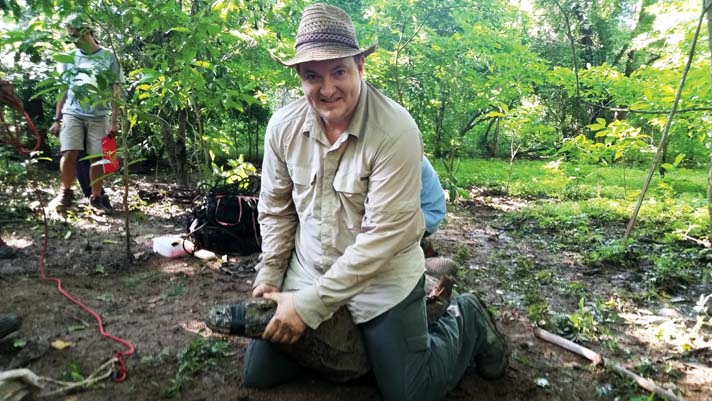
mike wines
The author holds onto a Komodo dragon.
Here’s how we caught the dragons: We set up 10 traps in different locations within one valley. A trap consisted of three 3-foot-long aluminum boxes wired together and baited with rotten goat meat tied to a cable inside. When a dragon grabbed the meat, it would pull the cable. A pin, holding the sliding door to the trap open at the other end of the cable, would be yanked free, and the door would slide shut with the dragon inside. It was a simple and safe way of trapping the animals.
Getting the dragons out of the traps was a different pickle. A small door, about the size of a deck of cards, was built into the top of each of the trap’s three sections. One of these would be slid open, and a rope would be lowered to noose the dragon inside. One person, usually Achmad, would pull the rope until the dragon’s head was pinned to the top of the trap. Someone else would grab the animal’s tail and, depending on the size of the lizard, either grab its rear legs or secure them with rope. Then the front legs were tied together, and, finally, the dragon’s head would be held while its mouth was taped shut. Sometimes the trap would then have to be dismantled if the lizard was too large to be pulled out safely.
Often, when I describe this process to people, they ask why the dragons aren’t sedated. Reptile physiology is much different from that of a mammal’s. I have helped with several surgeries on Komodo dragons. Once the lizard is finally unconscious from anesthesia (which can take several hours to take effect), it can remain knocked out for days, often needing someone to physically breathe for it. It’s much safer and less stressful in the long run (and less expensive) to catch them the way we did, without anesthesia.
Once the dragon was safely restrained, it was scanned for a microchip. Most of these animals were caught in previous years, and getting data on growing dragons was key to the research. Once the dragon was identified, measurements were taken, including weight, head width, length, snout-to-vent length, tail length, etc.
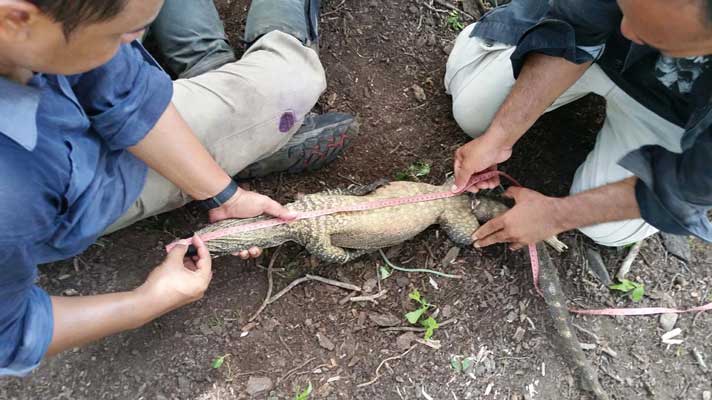
mike wines
Team members measure a Komodo dragon. After data has been collected, the monitors were marked and released.
If the dragon had not been caught previously, a microchip, much like the one you would put in your pet dog, would be implanted.
Once the data was taken, the dragon was photographed, marked with a glowing paint marker and set free. The temporary paint would let us know if a lizard in a trap had already been captured within the past few days. If so, we could release it without restraining it again.
The release was one of the more adventurous parts of the work. If it was a large dragon, a cloth bag would be put over its head. The several people sitting on it while the ropes were being untied held the feet, head, and tail safely in place. Then one person counted to three, and on three, everyone jumped off and ran while one guy protected the runners with a stick. The bag over the lizard’s head, which was tied to a tree with a long rope, would be pulled gently away as the lizard walked away, puffing.
The first day we caught seven dragons. The entire time, I pestered Achmad like an annoying little brother: “Hey, can I catch the next one?” I wanted to be the person who grabbed the tail, then moved to the feet, and on up to actually wrestle the dragon and restrain it. I wanted to do the dangerous part. I didn’t come all the way around the world for mostly adventure — I came for adventure, and to catch a Komodo dragon myself. Finally, after hours of me bothering him, Achmad said, “Today you watch. You learn. Tomorrow, you can catch the first dragon.”
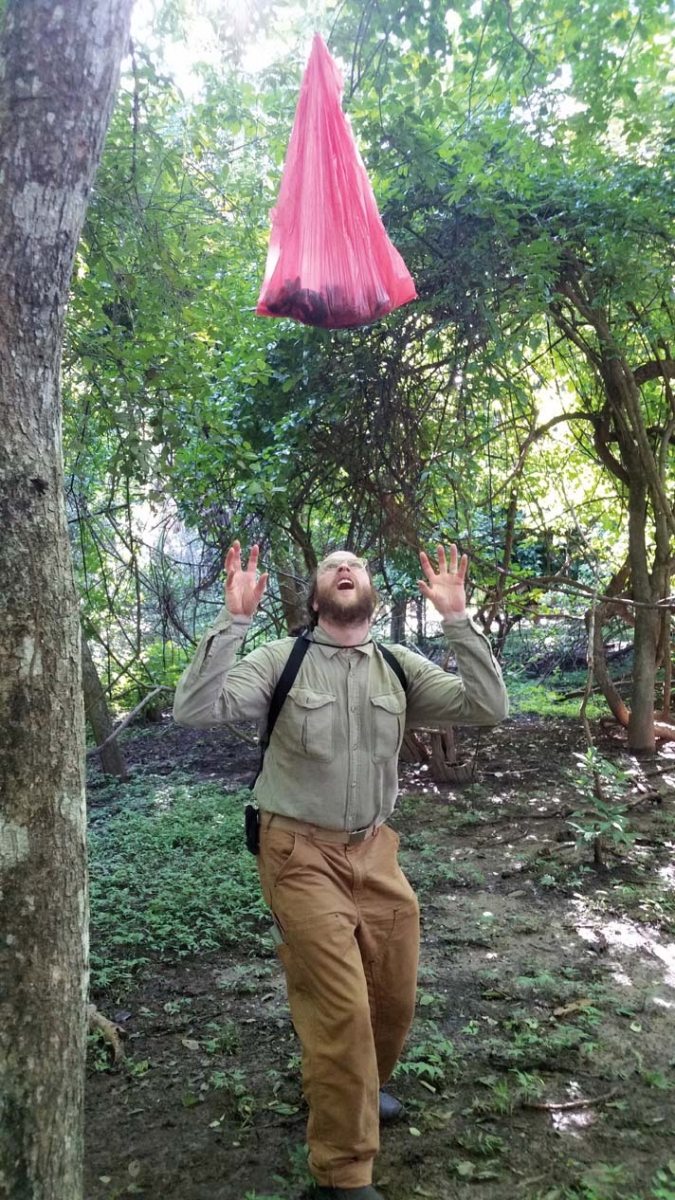
Mike wines
The bait of choice? Rotten goat meat.
The next morning, I was more excited than a Labrador at a tennis match as we headed out to catch my dragon. We walked up to the first of the 10 traps. The door was closed, so there had to be a dragon inside. I walked toward it, when Achmad told me to wait a second. I didn’t notice a huge dragon that was hanging around just outside the trap! It was sometimes hard to remember that there were dragons everywhere, and despite their size, they camouflaged perfectly.
Achmad decided we should catch the dragon outside of the trap first. He carefully slipped a noose over the animal’s head as Sidiq grabbed its tail. He handed the tail to me as he tied its legs. It was a very large dragon. I was secretly relieved they were doing the dangerous part on this one. He was in good shape and could do some serious damage if given the opportunity. It took about 30 minutes to capture, restrain, measure, and release the boy. Then it was on to the trap, and I was finally up to bat.
We walked over to the trap. There was definitely a dragon inside. You could hear it shifting around. I bent down to see the animal I would get to wrestle. It was ginormous. Everyone in the group had heard me asking for this chance for the entire previous day, and everyone was already beaten up from the last large dragon we caught. So they looked at the beast in the trap, then they all smiled, pointed at me and said, “Mike’s dragon,” in perfect English.
“Adventure,” I squeaked.
Komodo Dragonzilla
Let me completely set the stage for you. It was about 10 in the morning. The temperature was around 110 degrees. The trap was in the shade, but was made of aluminum, so still pretty hot inside. This gave the dragon plenty of energy with which to kill me. Have you ever seen those videos of bull riders sitting on the bull right before they open the gate, where the bull jumps or shifts and the whole gate moves? That’s the energy I felt coming up to the trap.
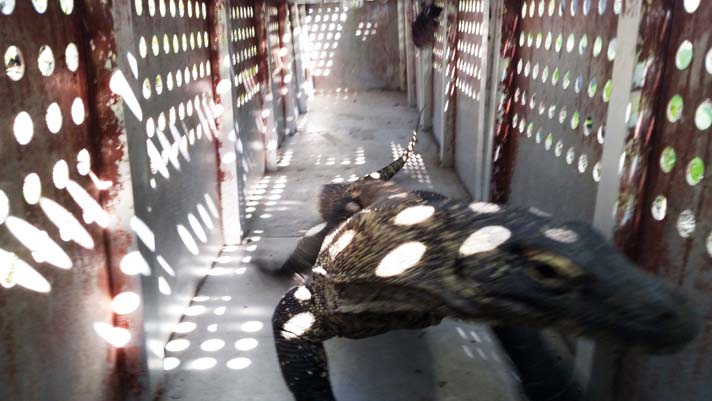
mike wines
A Komodo dragon in a trap.
So we have a monster lizard in a box. I haven’t mentioned the smell. The goat meat used for bait would be tied to a tree to rot. It smelled like the only Porta Potty at a national burrito-eating championship for skunks. The dragons could smell the rotting flesh from a long way away, and they would come running for their dinner.
Sometimes, after they got in the trap and ate the bait, they would get stressed from being captured. Like most reptiles when they are stressed, they would vomit. So not only was the goat meat rotten, it was also regurgitated. The dragon would then move around in the trap, marinating in the awful mess until we released it.
Ok, so here’s Dragonzilla — hot, full of energy, angry, covered in dragon puke — and he’s all mine to catch. My mouth has gotten me into some trouble over the years, but this might be the topper.
Achmad noosed him, but Dragonzilla was so big that when he moved his head, Achmad would move with him. We had to join together to move the trap near the trunk of a tree about nine feet away, where Achmad then wrapped the rope around the tree for leverage, so the dragon wouldn’t pull the rope from his hands. Did I mention it was a large animal?
It was my turn to act. This king of lizards was so big that we had to dismantle the trap to get him out. First, we unhooked the furthest section of the trap from his head. His tail uncurled before me, and I jumped on, ready to grab his rear legs and pull them behind him.
Dragonzilla wasn’t having it. He tossed me off his back with a simple flick of his tail. I scrambled to my feet and jumped back on. I had a job to do. If I didn’t do it, someone else in the group could get hurt, or the dragon could hurt himself. So I centered my considerable weight on his tail and stayed there until he stopped bucking. Then I pulled one huge foot out and held it behind him. It was not easy to get the second; it took me several strenuous minutes. Once I had them back, Sidiq tied them.
Then we unhitched the middle section of the trap, which had to be pulled over the dragon’s tail and tied legs. That required quite a bit of teamwork. Achmad and his crew had done this many times, so the operation went smoothly. I was on the dragon’s back, and Sidiq sat on his tail as I reached for the first of his front legs. It took a lot of work, but I got his arm back. The second one took longer, as the dragon was holding on to the side of the cage with his massive claws. We had to unhook each toe individually. His mouth had yet to be taped, and his jaws were snapping just inches from my hand. Finally, I wrestled the last leg back and we tied it.
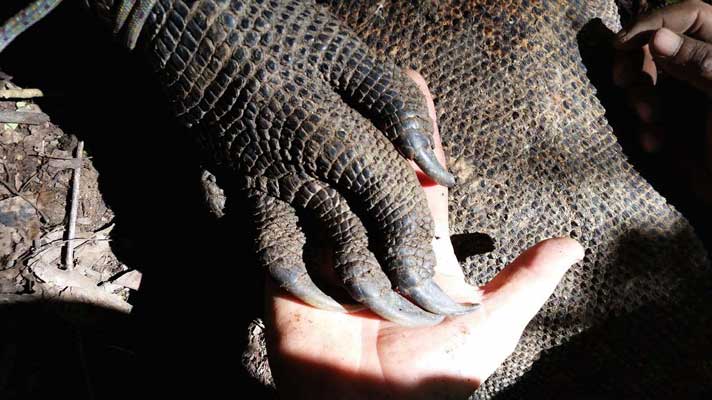
mike wines
One of Dragonzilla’s claws compared to the author’s hand.
I scooted up and slid both hands over Dragonzilla’s head and clamped his mouth shut. His head was so large that I could barely get my hands around his snout, but we got his mouth taped shut. He was restrained.
I didn’t even notice the smell until later, after I relaxed a little. I was covered head to toe in rotten, regurgitated goat, and had never been happier in my life. I did my job, and as it turned out, I was sitting on top of what turned out to be the largest dragon the team encountered that year, and no one, including the dragon, had gotten hurt (though I would be sore for several days after the struggle).
Dragonzilla measured out to be just over 10 feet and 231 pounds. Achmad and the crew had caught him seven times in previous years, and they had watched him grow. This year, at his biggest, I was lucky enough to help catch him. It was the adventure of a lifetime.
In total, we caught 40 dragons in 10 days. We had three trap locations and gathered a wealth of data for Achmad and the biologists at the Komodo Survival Program to use for further study.
Currently, this is the only group studying Komodo dragons in the wild. They have learned much, and have published 13 papers so far on subjects such as population status, home range, growth, and much more. They are also teaching the rangers on Komodo Island to gather the data, so Achmad and company can work on protecting the dragon populations on the other islands. They do invaluable work to protect and conserve this amazing animal.
You can learn more about the work that they do at komododragon.org. If you think protecting the world’s largest lizard is worthwhile, then please donate to the non-profit, as well. They have the support of the Indonesian government, as well as the AZA, but this doesn’t pay all the bills. They need help from people like you.
Michael P. WINES is the author of Stupid Alabama, and the reptile keeper at the Turtle Back Zoo in West Orange, N.J. If you liked this article, consider buying a copy of Stupid Alabama from Amazon.com.

